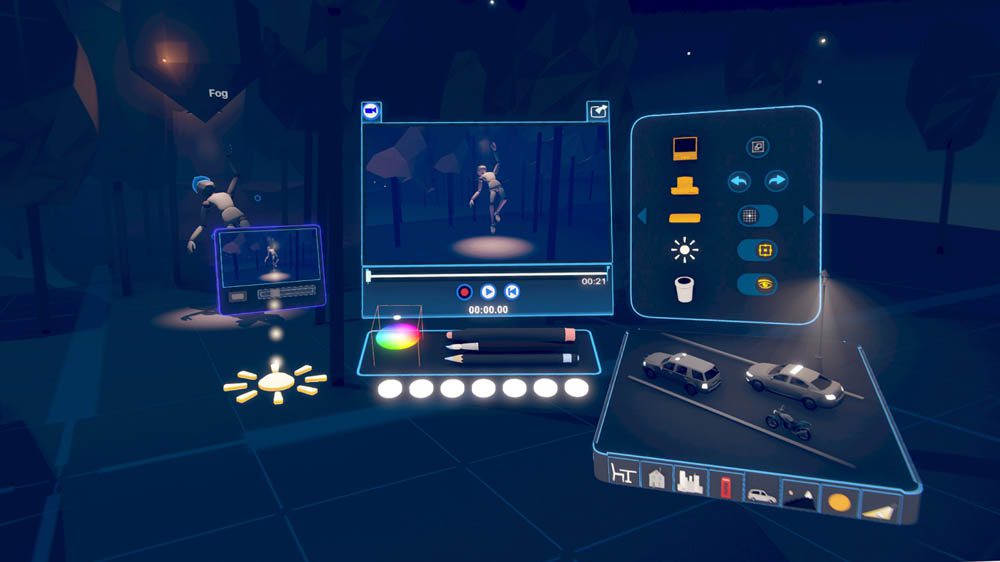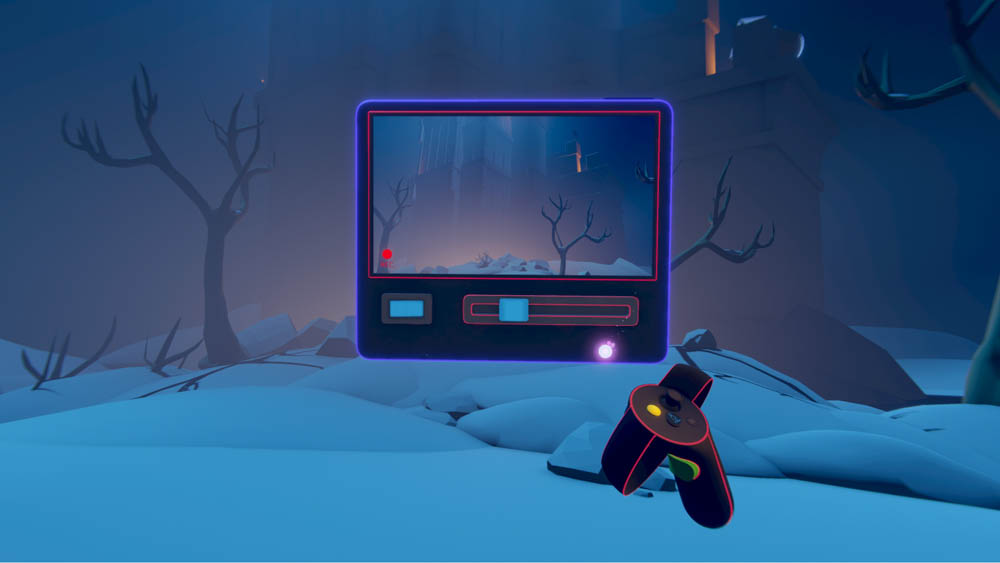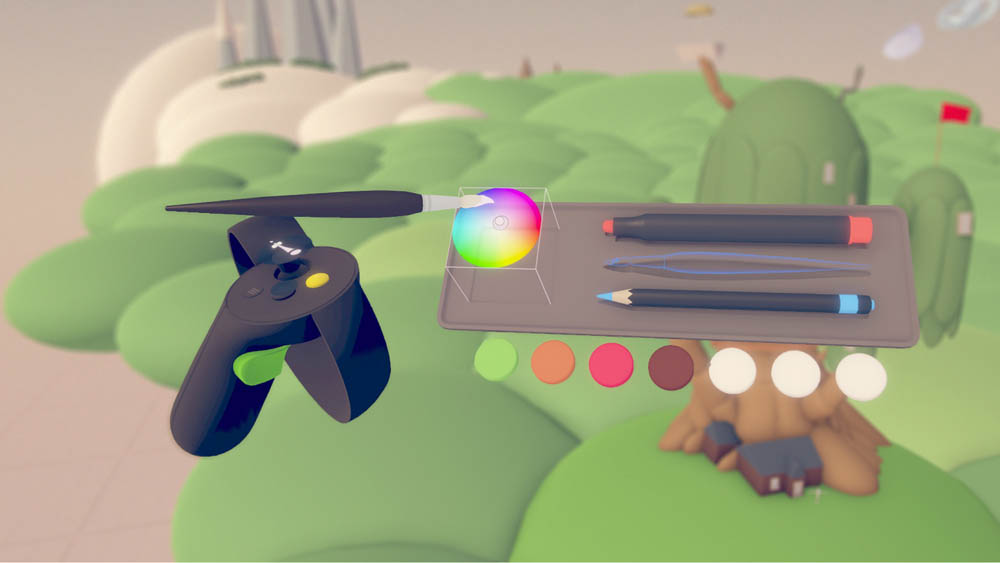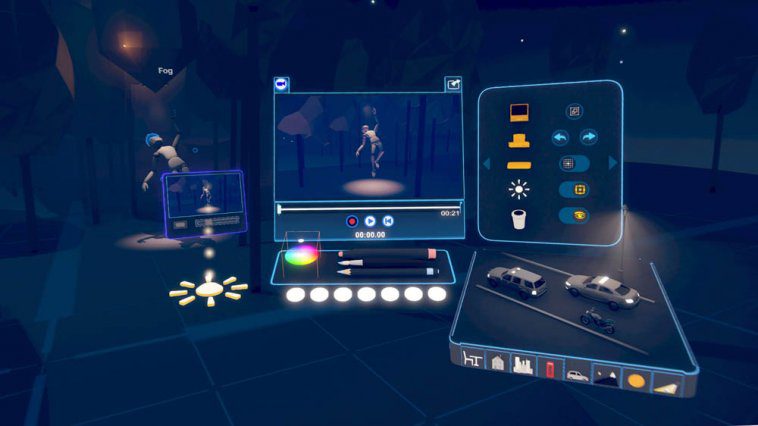Virtual reality has allowed creative professionals to do incredible things, but as VR matures, so do the tools available to help people achieve their best results. With new updates just launched, we reached out to the team behind 3D animation tool Tvori to get an update.
The answers below were provided by Viktor Komarovskikh, Dmitry Kurilchenko and Inga Petryaevskaya from Tvori. Questions by Nathan Ortega.
Tell us a bit about the Tvori team.
We’re a team of six people, and we also have a number of interns who work with us part-time. It’s quite a small team and there are lots of tasks, but there are advantages to having a small team. We try to work with maximum effectiveness; every team member is self-sufficient and works on a big piece of the pie. And this gives us a lot of inspiration and motivation, everyone is highly visible and influences the product development.
We are very focused on the development of the core functionality of Tvori and polishing existing features. We pay a lot of attention to working with our early adopters, gathering feedback from our creators and figuring out/analyzing what they need most.
We want Tvori to be intuitive and simple so that any person can start animating a story within several minutes after launching Tvori. We continuously revise our UI and study user experience—we see lots of ways how we can further polish and simplify our existing UI. We want to have a solid on-boarding process and tutorials to support our creators in their workflows.
What sort of background, development wise, did the team have before creating Tvori?
Viktor and Dmitry had both worked on VR prior to starting Tvori—creating games, products for agencies, winning at various competitions, and doing side-projects. Viktor [Komarovskikh—Founder, Product Development & Design] came from the 3D industry and has years of experience with creation tools—modeling, sculpting, and animation—which gives him an insight into what creators need. Dmitry [Kurilchenko—Founder, Product Development & Design] was developing products both in the position of designing and programming which gives him an insight into how to make the best experience using the technology at hand.
The rest of the team have software development, engineering, and mathematics backgrounds and are experienced in business and product development. And all of us are great believers in VR and VR creativity tools.

What inspired your team to create an immersive and powerful tool for crafting visual stories?
Back in 2012 with the new wave of VR, it became clear that VR would bring new opportunities in terms of how people work, communicate, and consume content.
Dmitry started experimenting with VR as soon as he got his hands on a VR headset—working on games and tinkering with ideas regarding collaboration, information visualization, and storytelling in VR; making prototypes and connecting with people from the emerging industry.
Viktor spent a number of years as a power user of 3DS Max, Maya, and other 3D creation software. He got to know all the limitations in regard to speed and design of those classical 3D tools, especially when it came to creating VR content using that kind of software, from testing the idea to the final result—the process was slow and painful.

With the insight on what future VR creators might need and the understanding on how to make the best experience for them, Tvori was begun in January of 2016.
The dream was to create a very simple, clear but also powerful creation tool so that anyone of different ages and backgrounds could create a story in VR. Tvori should enable people to realize their fantasy and dreams in 3D, and allow them to share creations with friends, and followers.
Developing a creation tool within innovative new technology such as VR provides exciting new possibilities, but also new challenges. Were there any particular hurdles you encountered when beginning to develop Tvori?
We worked with one of the first Vive dev kits back in 2015 for a week and were super impressed by it. But while we started Tvori in 2016 we didn’t get our Vives until May, so before getting a real 6-DOF VR headset, we had to make our own using what we had at that time. We used Gear VR (mobile VR), paired through the network to a PC that had Razer Hydra 6-DOF controllers on—we used that setup for the first version of Tvori. Here’s a video where we use handmade mobile VR with 6-DOF controllers.
After getting our Vive devkits we made an integration in a matter of a few days. Here’s the first video of Tvori running on Vive.
What are your thoughts regarding the role VR plays in the digital art community?
We see a huge potential of VR tools in art creation. The community of artists who are trying VR is growing fast, we see more and more 2D artists jumping directly into VR. They have never used any 3D software packages before and start creating in VR. In Tvori we keep saying that we want to democratize storytelling and animation so that anyone can create a complete story all within VR, or express their first ideas in 3D in form of a storyboard or animatic.
Tvori is in early access, with a projected development window of 3-4 years. How has Tvori changed over time?
Tvori was initially designed to enable anyone to create stories and art in VR, with the first version of Tvori released in 2016, following with more major updates in 2017. With a high focus on the simplicity and speed of creation, we introduced an intuitive and friendly user interface, where users learn by doing. This simple and direct approach led Tvori to the forefront of real-time animation in VR, giving our users a fantastic way to bring characters to life and be highly involved in the performance behind the characters simultaneously.
Though we will keep pushing to further improve our real-time animation mode, we strived to improve Tvori for multiple workflows, so in addition to real-time animation, we’ve introduced Keyframe Animation with 3D curve editing. This highly requested feature gave our more advanced users—digital artists, animators, and professional animation studios–more control over object and character motion, allowing for smooth and precise animation. You can now switch between the two modes to suit your personal workflow!
To enable our users to create large 3D worlds quickly and easily, we’ve added import of objects and models and have an integration with Google Poly. It is now very straightforward to build scenes and it takes much less time.
Right now we are working on the export of the animations to other software so that Tvori can be used in production pipelines by professional users and studios. But at the same time, we want to keep thinking of both user types—pro and amateur creators. So, it might happen that at some point we’ll distinguish between two versions, and this should allow us to keep the simplicity of the UX and not to overload Tvori with lots of advanced features.

Tell us a bit about how the community helped shape the evolution of Tvori since it entered early access?
Since we released our first beta back in 2016 we have been very open to feedback and comments from users. We do get lots of suggestions on functionality, bug reports, and just inspiring comments, and what is really amazing—our users are sharing their artworks! When we see a story, created in Tvori, we get lots of energy and appreciation. To give a concrete example, I would name the locker tool. We were conducting creators interviews and several users told us something like this—if you want to have a quick win, give us a locker tool so that we do not grab objects by accident. So, soon after those interviews, we pushed an update with a Locker tool. This was a 100% community driven feature.
Are there any features your team implemented where the community response surprised you?
Just recently we introduced a single hand workflow, i.e. you can do everything in Tvori with just one hand or one controller. One of our users was very happy as he had just broken his hand and thought he would have to wait for months until he could get back to creation in Tvori, but just a couple of days later we pushed that one hand mode. He made a post on Facebook that our update timing was perfect!
What are some of your favorite works created with Tvori?
We love each and every creation in Tvori. We’ve recently conducted the #TvoriTime contest to motivate people to share their works with the community. We have included works by #TvoriTime finalists into our Gallery at http://www.tvori.co/gallery
And here is a trailer which combines pieces from our finalists’ submissions!
What’s next for Tvori? Are there any exciting content updates on the horizon you’d like to share?
Aside from importing of animations, among most demanded features is sharing of VR stories made in Tvori with other people.
We want to dramatically improve the overall experience in Tvori—character customization, animation & scene creation process.
Once your team has completed development for Tvori, are there any future projects on the horizon planned in the world of VR?
We have a long-term roadmap for Tvori. It’s really a very ambitious plan and we hope to share it at some point. What is really important is to join the efforts in evangelizing VR and all the great opportunities this technology is bringing to the world. We decided that we want Tvori to be accessible for education and started a free license distribution program to educational institutions (schools, Universities, educational workshops about VR). So feel free to write at inga@tvori.com if you want to learn more about this program.
We are very happy every time we hear from our users. That’s true for both positive feedback and ideas for improvement/bugs reports because it helps us to further improve the tool. We also try to support our users in their creation process, and are happy to demo some advanced functionality of Tvori or fix something quickly to assure smooth creation workflow.
We’ve recently started our Tvori Support group on Facebook but anyone can also drop an email at hello@tvori.com. We usually respond quite quickly.
Thanks for talking with us!
Tvori is available now on Viveport and as part of Viveport Subscription.
Website: LINK


